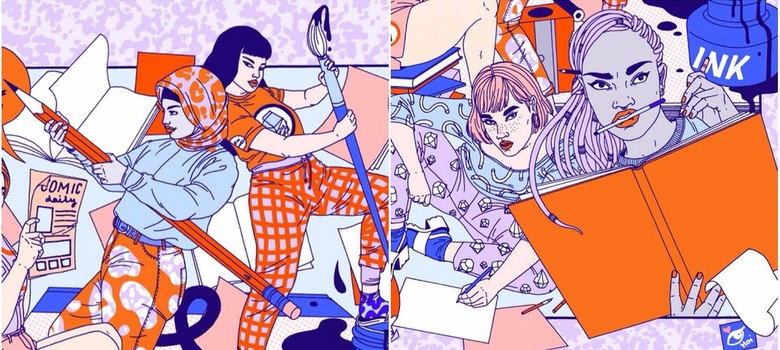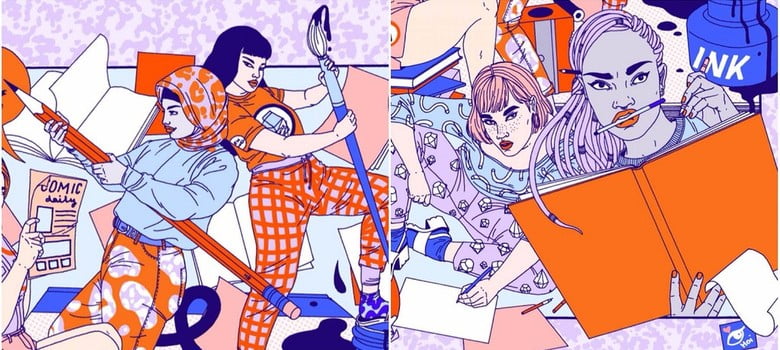
The year 2015 was a watershed for women writers of graphic novels. They swept the IgnatzAwards but then, as the year came to a close they shook the foundations the prestigious Angoulême Comics Festival in France by protesting against all-male 2016 Grand Prix nominee list citing gender discrimination. This resulted in the scrapping of the nominee list.
Against this backdrop, the first-ever all-women comics and graphic narratives exhibition in the UK – Comix Creatrix: 100 Women Making Comics – has gathered added significance. This exhibition includes works by 100 women cartoonists from across the world. And three (only?) of them are from India: Manjula Padmanabhan, Kaveri Gopalakrishnan and Reshu Singh.
In an email interview, Paul Gravett, the curator of the show and a world-renowned authority on comics, offered details of the show.
Gravett and Olivia Ahmad, who is House of Illustration (HoI)’s Exhibitions Manager, are the co-curators of the exhibition that will be open on 5 February and run till 15 May 2016 at HoI. According to Gravett they took about a year to put together this London exhibition.
“Essentially a year’, says Gravett who also in 2014 co-curated Comics Unmasked: Art and Anarchy in the UK at the British Library.
What is the theme of the Comix Creatrix?
There are several themes. The central theme is to correct the misapprehension that women have not made major contributions to the histories of comics and to their current vibrant creativity. We wanted to show that there is no limited definition of comics by women and that women are working in every genre – humour, horror, superheroes, autobiography, erotica, history, surrealism, reportage, science fiction, etc.
We also decided to include an opening section presenting a sampling of key pioneers, tracing right back to some of the very first women cartoonists working in London, Mary Darly in the 18th century and Marie Duval in the 19th century. After this, we added a section highlighting some of the innovators of the Sixties, Seventies and Eighties from the underground and alternative movements who paved the way for the modern graphic novel’s flourishing. And we wanted to mix British artists with non-British to give a wider global perspective and to include both established mature practitioners and younger emerging talents.
Despite the effort and significance of the show, when the list of women whose works will be exhibited was made public, one missing name did raise a few questions in the minds of graphic narrative fans here in India and abroad. Missing from this list was India’s most well-known woman comics artist Amruta Patil. Why did this happen?
With any exhibition, especially one limited to only 100 when as you know there are thousands of women making comics, past and present, worldwide, there will always be people and works left out. In fact, whole countries have been left out, inevitably with only 50 or so, as the exhibition is close to half British and half international. India is at least represented in Comix Creatrix, and with three artists.
But what prompted the selection of, say, a beginner like Reshu Singh over Patil?
Many other Indian artists were considered and, as you know, I have helped promote Amruta Patil’s work here in the UK, organising an event for Adi Parva at Foyles with Comica Festival (of which Gravett is a director) and the South Asian Literature Festival and commissioning a new strip from her for the ArtReview magazine. In the end, Olivia and I were keen to show the autobiographical pages by Reshu Singh and Kaveri Gopalakrishnan from the significant anthology Drawing The Line: Indian Women Fight Back. (Published last year, the book is a result of a workshop organized in the wake of the Nirbhaya rape in Delhi. At the workshop women artists from India told personal stories in the form of graphic narratives).
Who, then, are the three women comics writers who’re featured?
Manjula Padmanabhan
A pioneer in English comics in India, Padmanabhan is the first woman to run a newspaper strip – in the Sunday Observer between 1982 and 1986. Her protagonist Suki retained her cult status among readers of graphic narratives long after she stopped. Padmabhan is, of course, also well-known for her plays, illustrations and other genre of writing. “Olivia and I were thrilled to include Manjula Padmanabhan’s examples of her pioneering ‘Double Talk’ newspaper strip starring Suki from the early Eighties,” says Gravett.
In the male-dominated and -dictated world of comics where testosterone-dripping superheroes and scantily-clad heroines ruled the roost, Suki and Double Talk debut earned some initial scorn. However, the Sunday Observer editor Vinod Mehta continued to back the strip despite the readers, as Padmanabhan wrote in an Outlook magazine article, “calling the strip a horrible eyesore, ‘Double Gawk’, ‘dragging and brazenly repetitive.’” Many years later Penguin Books India published the Suki stories and the gawky young lady and her frog became a byword.
The Double Talk strips brought up many issues that readers of syndicated comic strips were not familiar with. Gender politics, in particular, did not go down well with readers then. For a long time, Padmanabhan did not go back to the comic form after Double Talk stopped, although she has resumed the strip now. In fact, she was a bit surprised that Suki was published. “In a culture where the birth of a daughter is regarded as a calamity and young brides are routinely murdered, what place is there for an awkward, fuzzy-haired girl whose best friend is a frog and whose favourite activity is sleeping late?” she wrote.

Kaveri Gopalakrishnan
A freelance comics artist and illustrator from Bangalore, Gopalakrishnan studied animation film design from National Institute of Design, Ahmadabad. Her sequential graphic narrative Basic Space is a part of Drawing The Line: Indian Women Fight Back. In aninterview with kyoorius.com Kaveri said that her work was “inspired by artists with strong content-driven or humour-based work.” Her inspirations are Brazilian brothers Gabriel Ba and Fabio Moon, Candian Guy Delisle of Jerusalem fame, and Luke Pearson the creator of Hilda.
She said in the same interview, “I used to document the things people did or said, ever since I started drawing as a toddler. This probably makes me an obsessively curious person; curious about other people and their quirks, which I still am.”

Reshu Singh
Singh is an illustrator and artist from New Delhi. She is an alumnus of the College of Art, New Delhi. Reshu’s short graphic narrative The Photo is a part of Drawing The Line: Indian Women Fight Back.

And the one who didn’t make the cut (but why not?):
Amruta Patil
Patil is India’s most well-known woman comics artist. She is known for her path-breaking long-form comic Kari, after which she published the equally significant Adi Parva. She was an artist in residence at Angoulême and panels from her forthcoming work Sauptik are a part of an exhibition at the ongoing Angoulême Comics Festival in France.
Patil has a fearless attitude towards comics. She took conservatives on with Kari, the country’s first long-form graphic narrative with a lesbian theme. Some of the imagery in the comic reminds the reader of Marjane Satrapi’s Persepolis, but Kari scores over Satrapi’s celebrated work on at least two counts: the sheer variety of themes packed into this little book, and the reinterpretation of celebrated paintings by artists like Andrew Wyeth or Frida Kahlo as though they were created as panels for use in Kari.
In fact, Patil uses the graphic novel form to pay tribute to her favourite painters. In aninterview with Helter Skelter, she says: “Adi Parva (the first of a trilogy on the Mahabharata) marks the beginning of my relationship with paint and painters. I’ve been feasting on all that is pigment-saturated. Odilon Redon. Paul Gauguin. Amrita Sher-Gil. Folk art from our subcontinent, but also from Mexico. The pages for collage are ripped out from fashion magazines, and the jewel box was an important motif.”
These images notwithstanding, Patil considers herself a storyteller. Her brush does speak a language rarely heard in the world of comics.





